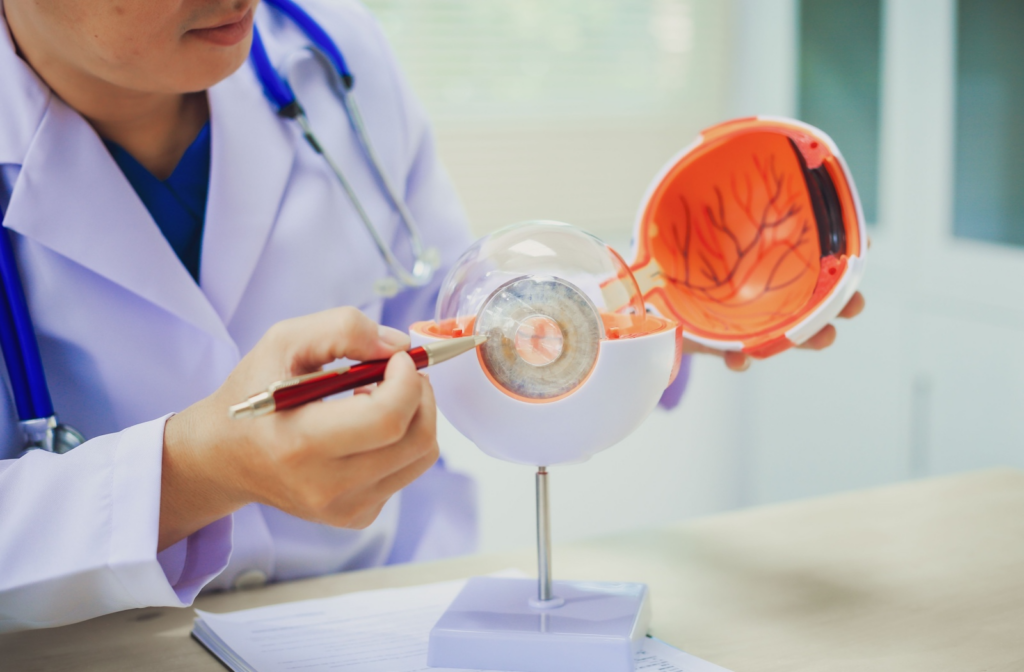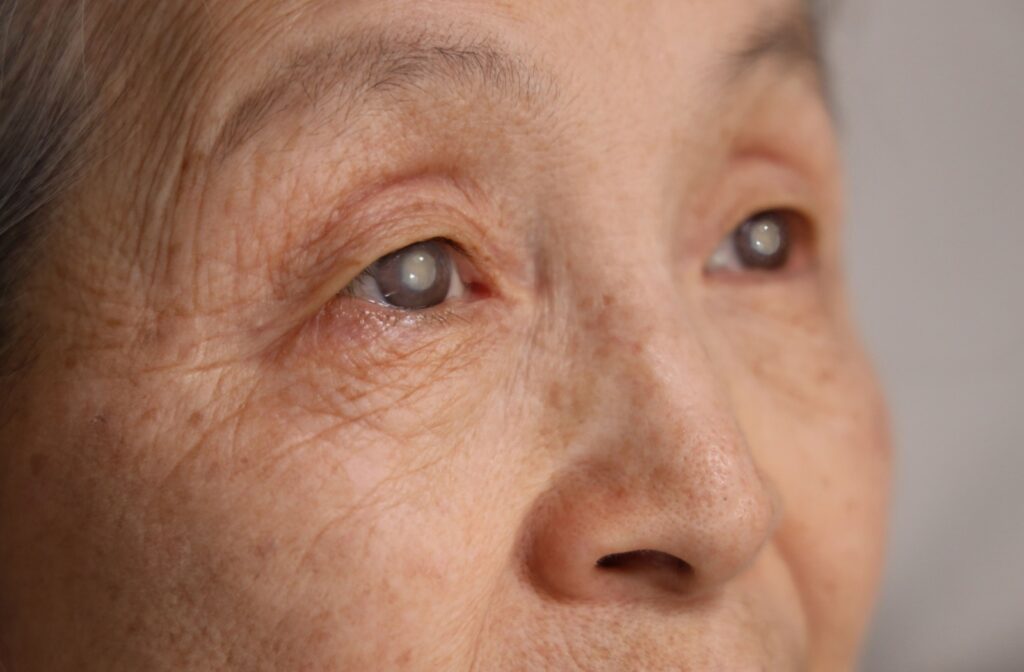Cataracts are a common age-related eye condition that can blur your vision, make colors appear faded, and even cause you to see halos around lights. For many people, it feels a bit like looking through a foggy window.
Cataracts can also cause double vision by scattering light across the eye, which affects how clearly images are formed. This symptom can be unsettling and may interfere with everyday tasks like driving, reading, or even recognizing faces.
What Is a Cataract?
A cataract is a clouding of the eye’s natural lens. Normally, the lens focuses light onto the retina (a tissue at the back of your eye) to create a clear image. When a cataract forms, the lens of the eye becomes cloudy and light scatters instead of focusing precisely, which leads to blurred or distorted vision.
Cataracts are most common in adults over 60, though they can occur earlier due to genetics, injury, or medical conditions such as diabetes. They can develop in one or both eyes, and they often progress slowly over time.
Cataracts are one of the leading causes of vision loss worldwide. Beyond double vision, this condition can interfere with driving at night, reading, and other daily activities that depend on sharp, clear sight. Because the clouding of the lens scatters light, cataracts reduce contrast sensitivity and depth perception, making it harder to judge distances or see in dim lighting.
Symptoms & Early Signs of Cataracts
Cataracts don’t always present obvious signs in their earliest stages. However, paying attention to changes in your vision can help you recognize them sooner. Some common symptoms include:
- Blurry or cloudy vision: Often as if seeing through a fogged-up window.
- Double vision in one eye: This happens when the clouded lens bends light unevenly.
- Increased light sensitivity: Bright lights or headlights may seem glaring or uncomfortable.
- Faded or dull colors: Objects may appear less vibrant.
- Frequent prescription changes: You may find yourself needing new glasses or contacts more often.
Because cataracts develop gradually, it’s easy to mistake these changes for normal aging. Regular eye exams can help you identify cataracts early, allowing your optometrist to help you keep your vision comfortable and clear.
How Cataracts Cause Double Vision
Double vision, or diplopia, occurs when your eyes perceive two images of a single object. Cataracts can create this effect by scattering light as it enters the eye, which disrupts how the image is focused on the retina. Unlike double vision caused by muscle or neurological issues, cataract-related double vision usually happens in just one eye.
This type of double vision can feel disorienting and frustrating, especially when you’re reading fine print or focusing on detailed tasks. In many cases, double vision may lessen as a cataract progresses, but that doesn’t mean the problem has resolved. Instead, it typically signals that your cataracts are worsening.
Treatment Options for Cataracts
Fortunately, cataracts are very treatable. Depending on the stage of the cataract and your overall eye health, your doctor may recommend:
- Eyeglasses or contact lenses: Early on, updating your prescription may help sharpen your vision.
- Cataract surgery: When vision becomes significantly impaired, surgery is the most effective solution. During this procedure, the cloudy, natural lens of your eye is removed and replaced with a clear, artificial lens.
There are different surgical methods available, including phacoemulsification (using ultrasound waves), extracapsular extraction, and laser-assisted techniques. Your eye doctor will determine which approach is most appropriate for your eyes and lifestyle.
Cataract Prevention Tips
While cataracts can’t always be prevented—especially when they’re related to aging or genetics—healthy lifestyle choices may lower your risk or slow their progression. Consider these strategies:
- Wear UV-protective sunglasses: Shield your eyes from harmful ultraviolet rays.
- Quit smoking: Smoking is a significant risk factor for cataracts.
- Eat a nutrient-rich diet: Foods high in antioxidants, vitamin C, and omega-3 fatty acids support eye health.
- Manage medical conditions: Keeping blood sugar levels in check is particularly important for people with diabetes.
- Schedule regular eye exams: Routine visits allow your optometrist to catch early signs of cataracts and other eye conditions.

When to See Your Eye Doctor
If you’ve noticed changes in your vision—especially double vision, cloudiness, or increased light sensitivity—it’s important to see an eye doctor. While eyeglasses or contact lenses may help in the short term, cataracts typically progress over time. Early detection means your doctor can recommend treatments that protect your vision until surgery becomes necessary.
Protecting Your Vision in Reno
Cataracts are a common, treatable condition that can cause double vision and other disruptions to your sight. With early detection and proper treatment, you can continue to enjoy clear, comfortable vision. If you suspect you have cataracts or are experiencing symptoms like double vision, our team at Dr. Jennifer L. Shane & Associates in Reno, NV is here to help. Schedule a comprehensive eye exam today and take the first step toward clearer vision.



